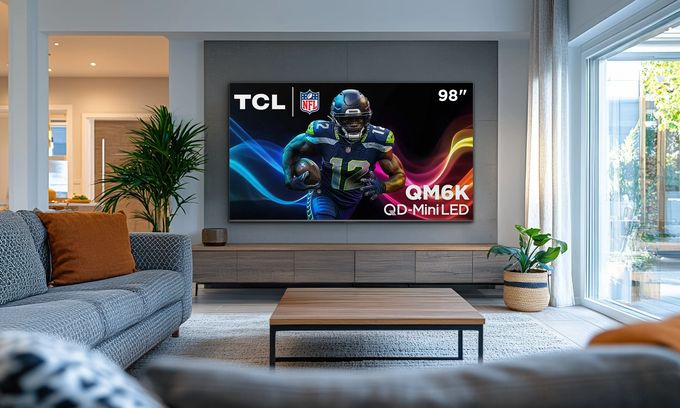The rise in popularity of Home Theaters has been going on for several decades. Today, this concept is realized mainly due to huge TVs и Home Theaters projectors.
A few years ago, ultra-short-throw (UST) and mid-focal projectors were virtually unrivaled. Priced from $ 1,500 to several thousand, they offered a huge image of 100″-150″ diagonally and fairly high image quality. At the same time, the price of 100-inch TVs started at $ 15,000, radically limiting their marketing prospects in the mass segment.
But not wanting to lose a promising segment, several years ago the leaders of the TV industry rushed to chase projector manufacturers. Perhaps, the Chinese TCL can rightfully be positioned as a pioneer in the segment of relatively affordable huge TVs. This company announced in 2021, and at IFA 2022 presented its TCL XL Collection. In fact, 98-inch TCL 98R754 QLED 4K TV became the first relatively affordable TV with an announced launch price ‘only’ $ 8,000. For reference, today it costs ~ $ 3,300.
Over the past few years, industry leaders including Samsung, Hisens, Sony, LG and TCL have filled this niche vigorously, introducing premium 100-inch TVs at quite affordable prices ranging from $ 3,000 to $ 6,000. Almost all models use quantum dot (QD) technology, which provides high brightness, color accuracy and a wider color gamut. Moreover, many 100″ TVs use innovative mini LED backlight, providing superb contrast with local dimming.
CES 2025 demonstrated the continuation of the trend for increasing screen sizes. For example, fans of the cinematic format in the apartment this year received a superb 100-inch TCL QM6K for $ 3,500.
TCL QM6K
The number and innovative level of technologies will impress even the most imperturbable Scandinavian. In the new series, the company has implemented almost all video processing innovations that were developed in TCL Pangu Lab. The QM6K will be called the Precise Dimming Series. Scott Ramirez, VP, Product Marketing and Development, Home Theater used the ‘Affordable Premium’ tagline.
The series uses 2 main innovations of LED TVs, including quantum dot (QD) technology and mini LED backlight.
In fact, QD increases brightness and color accuracy, and also expands the color gamut by using high-quality white for backlight, which is generated from blue, green and red.
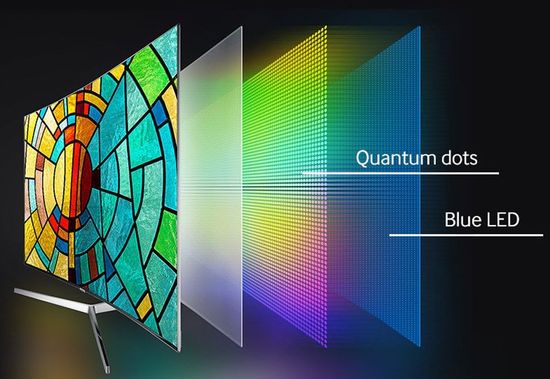
Blue comes from the rear array of blue LEDs. Red and green are re-emitted by microparticles that partially absorb the blue flux. Their size corresponds to the wavelengths of red and green.
Microparticles are sprayed onto a film that is placed between the blue backlight and the RGB filter. By combining three primary colors, the TV generates high-quality white, which is used to backlight the RGB filter.
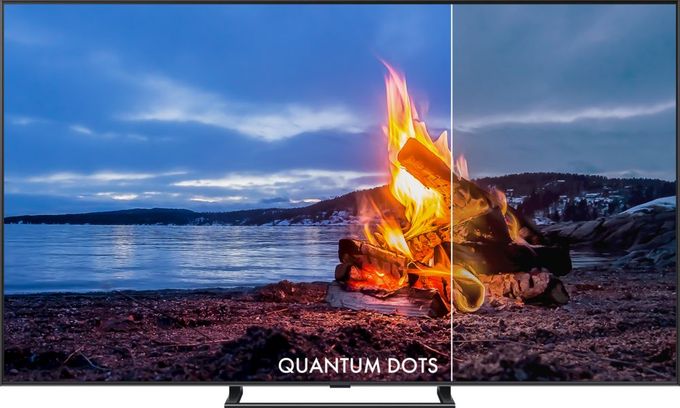
Mini LED backlight has become an equally epochal breakthrough in LED TVs. It provides superb contrast due to the high performance of local dimming, which uses FALD (Full-Array Local Dimming) with mini LEDs. A radical reduction in the size of LEDs allowed developers to increase their number to tens of thousands.
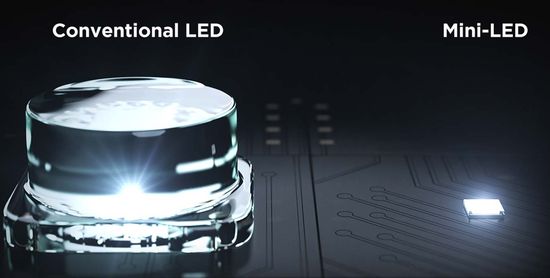
Then they are divided into hundreds and even thousands of local dimming zones with separate control of their brightness. As a result, the control system can very accurately regulate the brightness in individual areas of the screen depending on the frame content. For reference, this technology was developed at TCL Pangu Lab.
All-Domain Halo control technology
In addition to these two fundamental technologies, which have already become commonplace in the premium segment, TCL has implemented several new innovations. The company called their totality All-Domain Halo control technology. In fact, it includes several sub-technologies that cover all stages from light generation to imaging:
– newest TCL’s high-efficiency light-emitting chip.
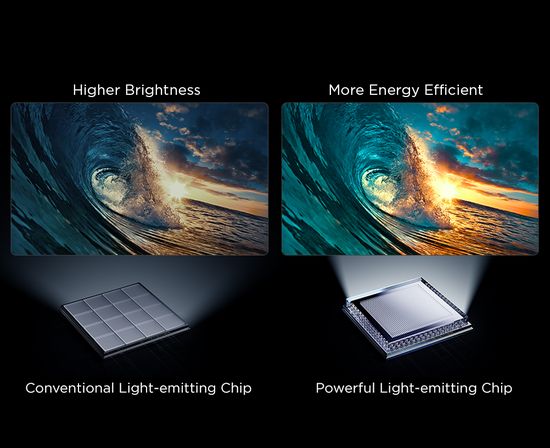
The new LED chip increases brightness output by more than 53%, while also increasing light efficiency by 10%;
– Condensed Micro Lens.
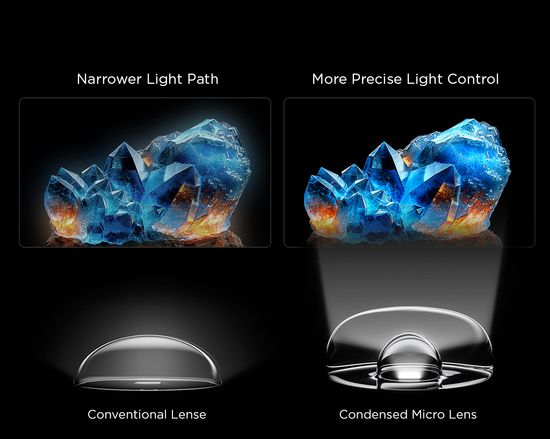
The new Condensed Micro Lens is a upgraded version of the 2024 UWA Dual Arch Lens;
– Micro-Optical Distance technology (Micro-OD).
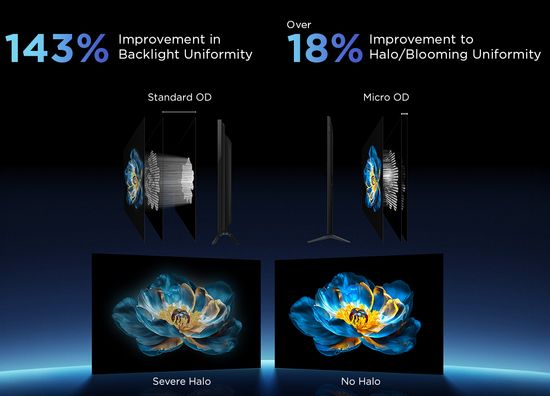
– TCL HVA Panel technology, including bi-directional backlight 23-bit controller, Zero-Delay Transient Response and Dynamic Lighting Algorithm (light and shadow control algorithms).
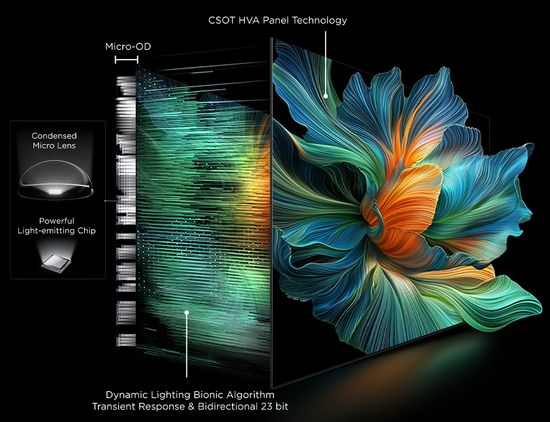
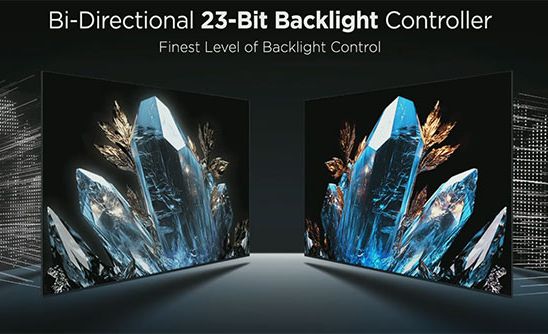
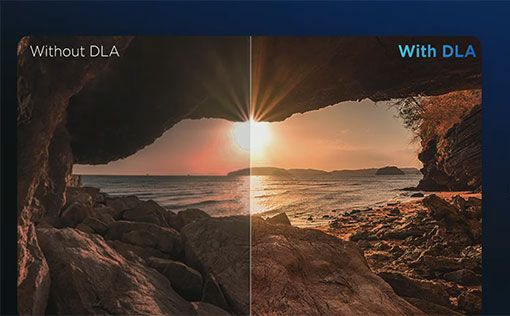
In fact, this algorithm renders SDR format into near-HDR signals.
The company claims an unprecedented 7,000:1 native contrast ratio for the new panel. The QM6K supports 4K 144Hz native refresh rate, eliminating the problem of image stuttering. Motion rate 480 with MEMC frame insertion provides motion clarity, combining multiple motion enhancement technologies. For gamers, the new series offers Game accelerator 288 VRR, providing very responsive gameplay without lag even in ‘heavy’ games. AI Optimization includes AI Contrast, AI Color, AI Clarity, AI Motion, AI HDR and AI Scene.
ONKYO 2.1ch system with subwoofer supports DTS-HD / DTS Virtual:X and will allow even music lovers to save on the purchase of an external soundbar.
The ultra slim design with integrated cable management and Google TV triumphantly complete the incomplete list of bonuses.
LG, Hisense and Samsung
Despite the abundance of offers, the list of new relatively affordable premium huge TVs is very limited.
Indeed, the price of the new 97-inch wireless LG OLED M5 and flagship G5 will clearly not be budget-friendly. For reference, last year’s 97-inch LG G4 and M4 today cost almost $ 20,000 and £ 28,000, respectively. In fact, in this price segment, company offers only the 98-inch LG QNED89T (98QNED89TUA, 2024) with QD technology and mini LED backlight, which today costs ~ $ 5,000.
116-inch Hisense 116UX TriChroma and 136-inch micro LED panel are also unlikely to surprise with an ‘affordable’ price.
The new wireless version of 98-inch Samsung QN990F 8K with Omni-Directional technology comes with One Connect box and also has nothing to do with the budget segment. The flagship QN90F also contains a 98-inch model. But last year’s 98″ QN90D 4K costs ~ $ 10,000 today. Its updated version is unlikely to be cheaper. So the list of new affordable Samsung huge TVs with premium technology is actually reduced to the 98-inch model of QN85F series. In fact, it’s the cheapest Samsung series with QD technology and mini LED backlight.
Unfortunately, there is no information about prices and specs yet. The maximum size in last year’s QN85D series reaches only 85″. This model today costs ~ $ 2,200. Extrapolating the price difference between 85″ and 98″ TVs, we can assume the cost of such a hypothetical model from $ 3,000 to $ 3,500. In this case, the estimated price of new 98-inches QN85F can be up to $ 4,000, which is quite comparable with the 100-inch TCL QM6K for $ 3,500.
Conclusion
Despite the long list of new huge TVs, only the 98″ TCL QM6K can be positioned as a budget-friendly model with premium technologies. However, the 98-inch Samsung QN85F with an as yet unknown price may expand this list. The prices of the superb huge LG OLED M5 / G5, 116-inch Hisense 116UX TriChroma and 136-inch micro LED panel, Samsung QN990F 8K and QN90F clearly cannot be classified as ‘affordable’.
The price-quality ratio of the huge TLC QM6K is comparable to projectors, including mid-focal and ultra short throw (UST) models. The price of mid-focal models at the lower premium segment ranges from $ 1,500 to $2,000, UST projectors with similar specs are several hundred dollars more expensive. Many modern mid-focal projectors are compact and about twice as light vs UST models (~5 kg vs 10 kg). Accordingly, they are more convenient to carry, for example, to the yard. But UST projectors, due to the use of aspherical mirrors, form a huge image from a distance of several tens of inches, eliminating the problem of wires on the floor when placed in the living room center.
In addition, for an acceptably image quality, projectors require a Ceiling / Ambient Light Rejecting screen, the price for which ranges from several hundred to several thousand dollars. In general, the cost of a projector with a screen reaches $ 3,000 – $ 3,500, which is approximately the same as the price of the TLC QM6K.
This video shows Hisense TriChromaLED TV and 136-Inch MicroLED panel at CES 2025.
